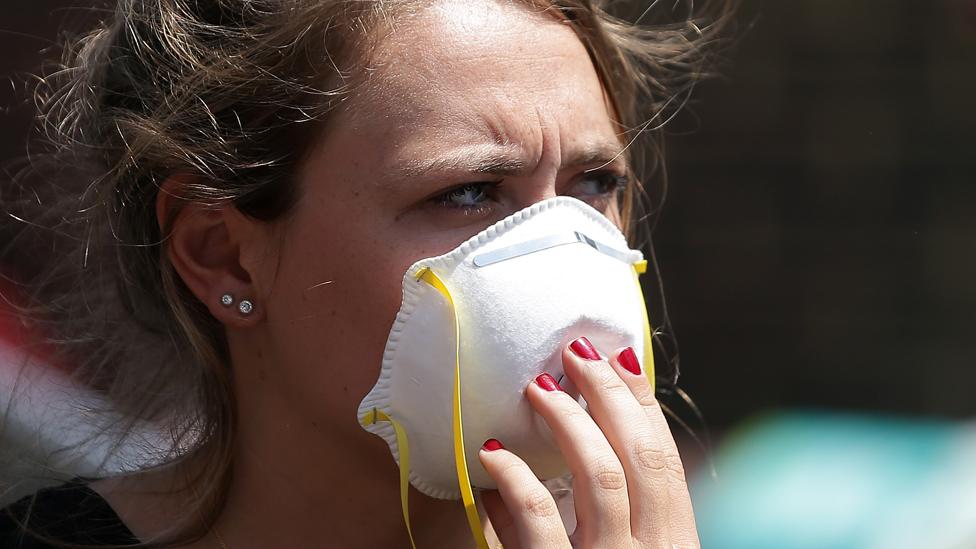The terrible speed with which the Grenfell fire spread
- Published
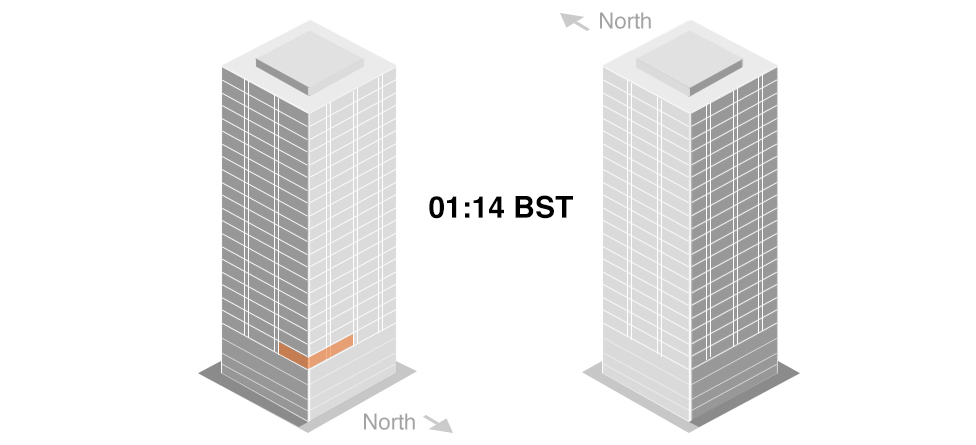
Seventy-two people died as a result of a huge fire that engulfed Grenfell Tower - a 24-storey West London residential tower block. This week expert witnesses at an inquiry into the blaze detailed how the fire ripped through the building, minute by minute, one year ago.
Fire starts on fourth floor, spreads in minutes
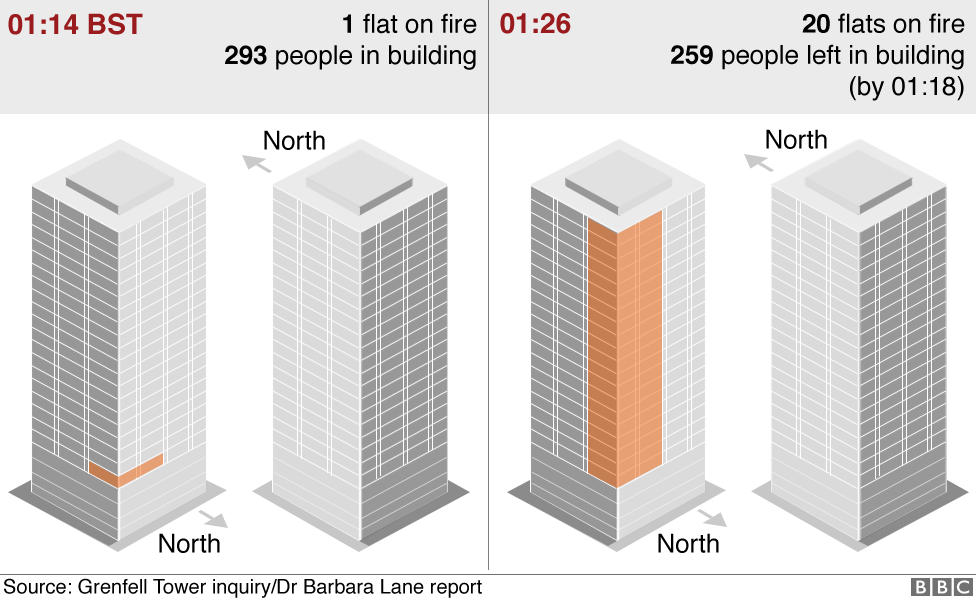
00:54 BST
The first call was made to emergency services to report a fire on floor four of Grenfell Tower just before 01:00 on 14 June 2017.
The man who lived in flat 16, Behailu Kebede, told the operator: "Quick, quick, quick. It's burning."
He described how he was woken by a smoke alarm and had seen smoke in his kitchen.
Four fire engines were sent to the scene, the first arriving at 00:59.
01:02
A few minutes later, the fire could be seen in the flat from outside the building. It had spread from the kitchen window to the exterior and witnesses began seeing burning material falling to the ground.

Around this time, Tiago Alves, then aged 20, ran down the stairs from the 13th floor with his younger sister Ines.
CCTV showed their father, Miguel, leaving the building a few minutes later along with other residents - possibly fellow occupants of the 13th floor.
01:07
The first fire crew entered the flat, reaching the kitchen by 01:14.
Firefighter Daniel Brown described seeing an "isolated curtain of flame from about 2-3ft in the air to the ceiling".
Thermal images captured by the fire crew appeared to show "hot fire gases and flames had spread across the window space".
Barefoot and clutching his phone, the flat's tenant, Mr Kebede, left the building and watched in horror as the fire spread up the tower.
His mobile phone images show an orange glow of flames around the kitchen window, and later a fire burning more intensely in the area of the window filler panel and extractor fan.

01:14
The blaze was moving up the building's east side by this time and the fire service made its first request for a high-reach aerial appliance.
One minute later, the fire had spread to the 5th floor above. Fire crews began using external hoses to try to extinguish the flames.
Further burning debris could be seen dropping from the building.
01:21
Within a further six minutes, the fire had reached the 11th floor. One minute later, the fire had reached floor 13.
A resident of flat 195 on the 22nd floor called emergency services to describe smelling smoke, but was advised to "stay inside and keep your door and windows shut".
CCTV showed a number of people leaving from the 7th floor.
A few minutes later, someone on the 14th floor said people could no longer exit via the lobby because it was filled with smoke.
01:26
Mobile phone videos show the blaze reaching the top floor on the east side of Grenfell Tower by about 01:26, less than 30 minutes after firefighters had arrived.
In approximately 12 minutes, it had spread up 19 storeys on the outside of the building.
A resident of flat 95 on the 12th floor called 999 to report that the fire had reached her neighbour's flat. The flames were "coming through the floor", she said.

The fire service was still telling residents to "stay put" at this point - advice that lasted nearly two hours.
Such "stay put" safety advice is often given to people living in purpose-built blocks of flats. It is designed to stop residents unaffected by fire from unnecessarily evacuating the building and blocking the stairways.
However, it assumes a building's design will contain a fire in a single flat for as long as it takes fire crews to bring it under control.
Dr Barbara Lane's report found that this policy had "effectively failed" barely half an hour after the fire started, given the unique circumstances at the tower block.
There was an "early need for total evacuation of Grenfell Tower", she said.

Major incident declared

01:29
The number of 999 calls to emergency services increased as the fire reached the top of the building.
In desperation, some residents had headed upwards and were seeking refuge in flats of friends and neighbours on the upper floors. Smoke was coming from "everywhere", one said.
London Fire Brigade increased their request for vehicles with pumps to 20 at this point. Two minutes later, crews asked for 25 pumps.
People on the 3rd, 11th, 20th, 22nd, 23rd went on to make emergency calls to describe flames or smoke reaching their flats.
01:38
The fire continued to advance on two fronts - along the eastern side of the building and to the north. A total of 144 people had evacuated the building by this point, but 149 remained inside.
The fire service received a call from flat 205 on the 23rd floor, where flames "just blew" into the kitchen.
The occupants of flat 95 on the 12th floor also described a fire in the neighbouring flat, on the landing and near the lift, as well as below and around the flat's windows. They were advised to leave.
People on the 10th, 12th, 14th and 22nd floors also called 999 around this time and described being trapped in smoke-filled flats. Some said they were going to try and escape.
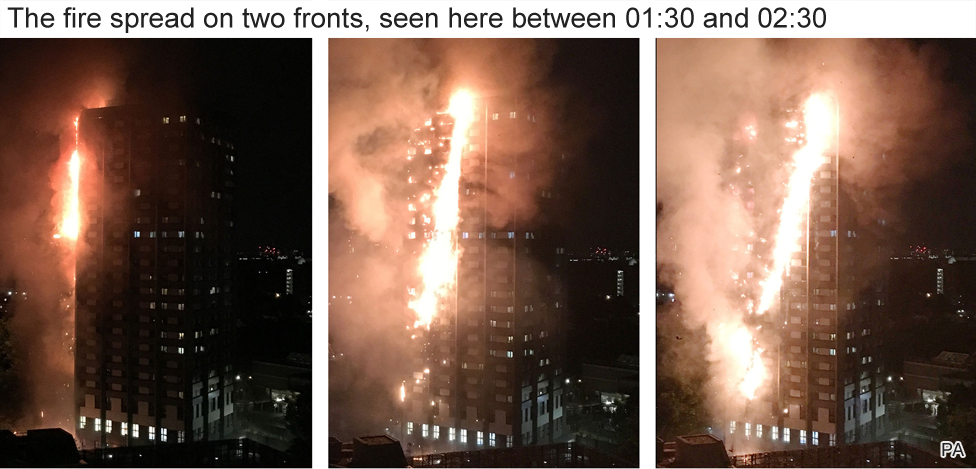
01:52
As well as 26 flats ablaze externally, at least four flats were on fire inside by this time, according to the report by Dr Barbara Lane.
The number of people escaping the building slowed, however. There was a period, between about 01:50 and 02:06 when no-one left, according to the report by Professor José L. Torero., external
This was the point when communal lobbies and stairwells in the middle and top of the building became, or appeared to have become, impassable.
"Thick smoke with low to zero visibility is described as filling the stair," said Dr Barbara Lane.
02:06
London Fire Brigade declared a "major incident" just after 02:00. They had requested 40 pumps by this point.
People started leaving the building again, but at a reduced rate. The reason for this is not clear, Prof Jose Torero said in his report, however, it corresponded with the point when the fire reached the centre of the building's east side and the north side, creating "untenable" conditions.
The fire spread across the north side of the building a few minutes later and fires were raging inside a number of flats.

Stay-put advice changed

02:23
The number of interior fires increased as the fire spread across the exterior of the building and by 02:25, the fire had spread to the south side of the building. Five minutes after that, at 02:30, the whole of the east of the building was on fire, Met Police records show.
02:47
The incident commander changed the policy recommending residents stay in the building at this point and people were advised to leave. By this time, the east, north and south sides of the building were in flames.
Before the stay-put advice was changed, 187 occupants had left the building - independently or with firefighter assistance. There were still 107 people in the building, of which 36 eventually got out.
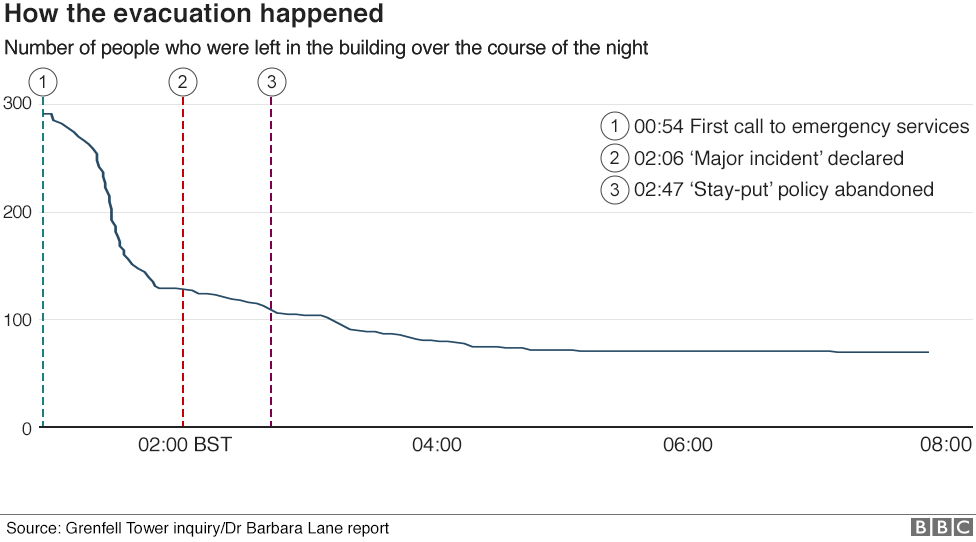
People inside the building described lobbies as "incredibly hot" or "boiling hot" as well as thick with smoke at this time, Dr Barbara Lane said.
"This smoke effectively created a barrier to residents on any level and so impacted on their ability and/or willingness to move from their flats down the stair to a place of safety," she added.

North of building fully ablaze
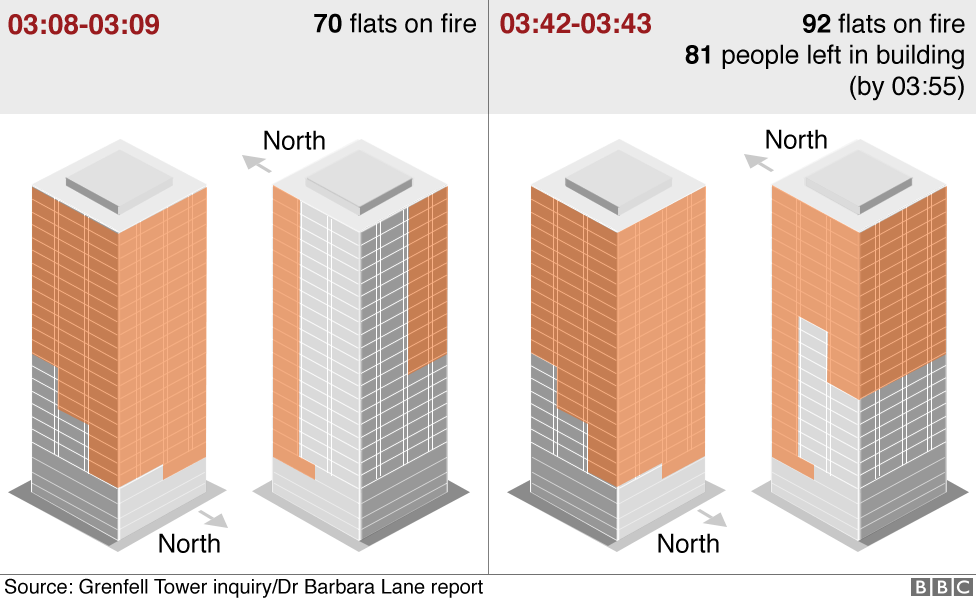
03:21
Some 73 flats were ablaze externally by 03:21 and two minutes later, the northern side of the building was fully alight.
By 03:39, London Fire Brigade had stopped sending crews above the 4th floor.
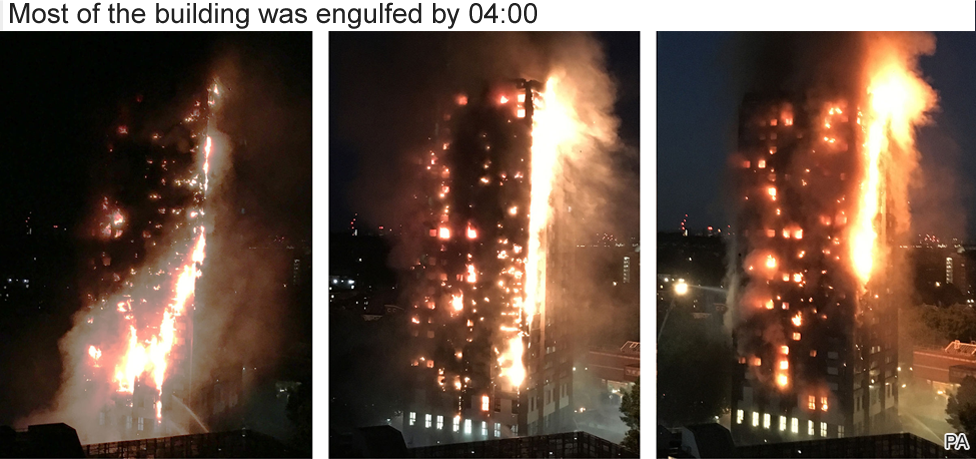
The fire continued to spread towards the south-west corner of the building, reaching it by 03:56. No-one escaped from above the 12th floor after 03:55.
Just before 04:00, 81 people were left in the building.

Whole building on fire
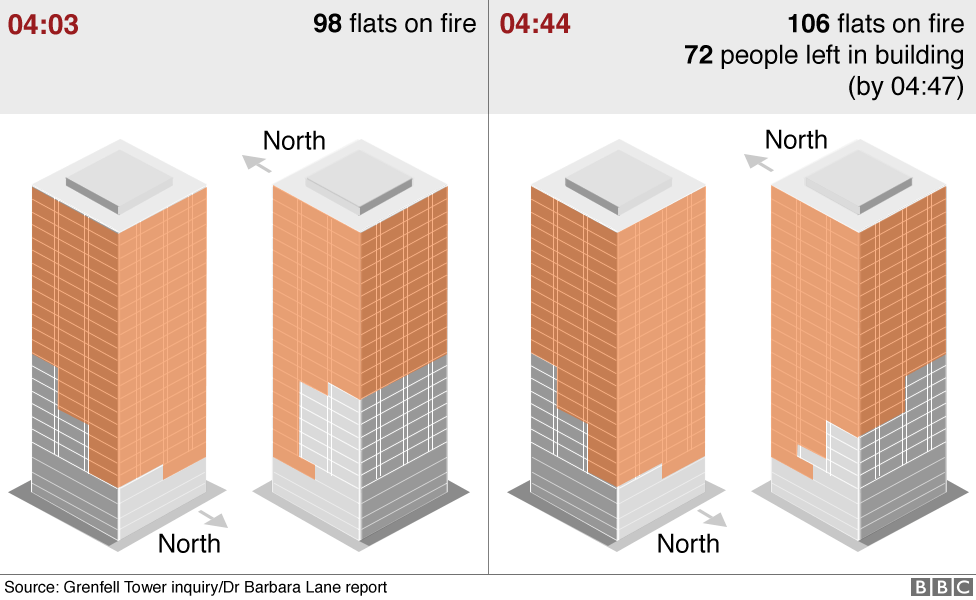
04:03
The fire spread laterally around the building to the north and south, and just after 04:00 it had reached all sides.
The flames had spread in different directions and converged on level 23 near the south-west corner of the building, fully enveloping the building's perimeter.
04:31
Fire could be seen spreading down the building on the west side and it was fully engulfed just before 05:00. Internal fires continued to rage.

08:07
Some 70 people had not evacuated the building at this stage.
19:55
The incident commander concluded that there was "no longer any saveable life in the building" just before 20:00. Internal fires could still be seen on the north and west sides of the building at 21:50.
01:14 (15 June)
The blaze did not burn itself out until 01:14 BST on Thursday 15 June - 24 hours later - having destroyed 151 homes, both in the tower and surrounding areas.
A total of 72 people lost their lives as a result of the fire.
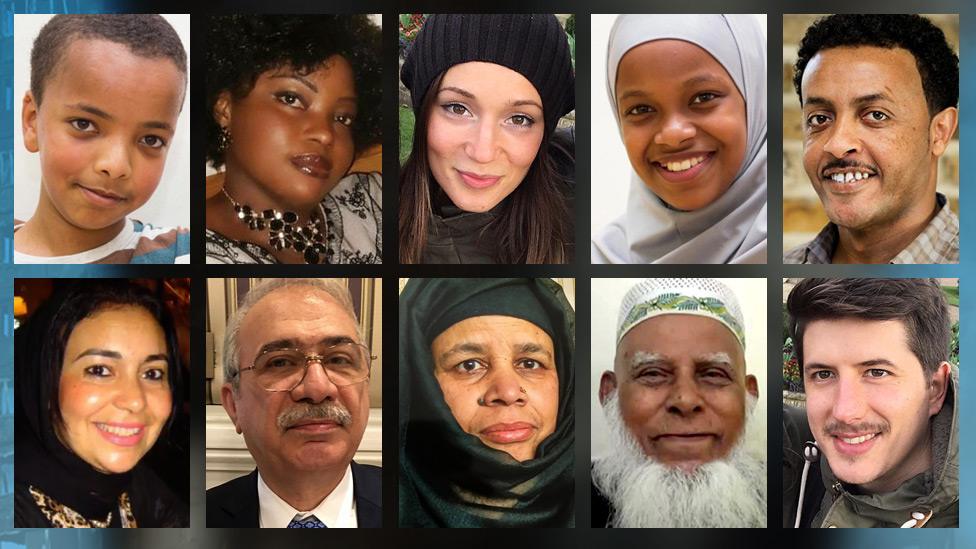
They include six members of the Choucair Family and five members of the Hashim Family, who lived on the 22nd floor. Five members of the El-Wahabi family died on the 21st floor.
Six-month old baby Leena Belkadi died in her mother's arms as she tried to escape and baby Logan Gomes was stillborn in hospital the morning after the fire.
Maria Del Pilar Burton, who suffered from serious long-term health issues, died in hospital in January 2018.
A total of 65 people were rescued from the building by firefighters.


In a statement to the inquiry, London Fire Brigade said Grenfell Tower was the largest single rescue operation in England since World War II.
It was "by far the most challenging incident" the service had experienced "in living memory", it said.
The Fire Brigades Union has asked the inquiry to consider whether firefighters were put in an "impossible situation" when battling the blaze.
Note: All timings as reported to the Grenfell Tower Inquiry., external
Written and produced by Lucy Rodgers. Designed by Gerry Fletcher, Zoe Bartholomew, Mark Bryson and Sumi Senthinathan.
- Published29 October 2019
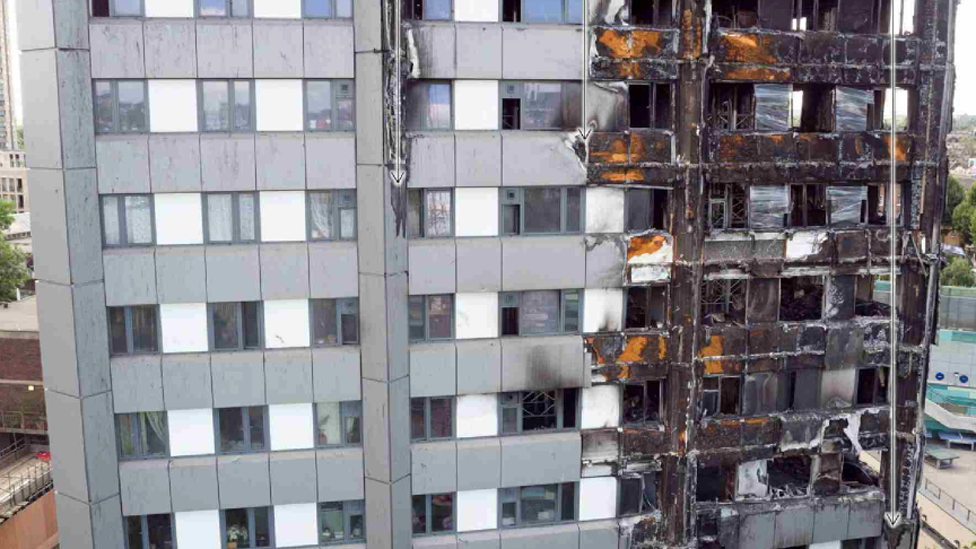
- Published14 June 2017
